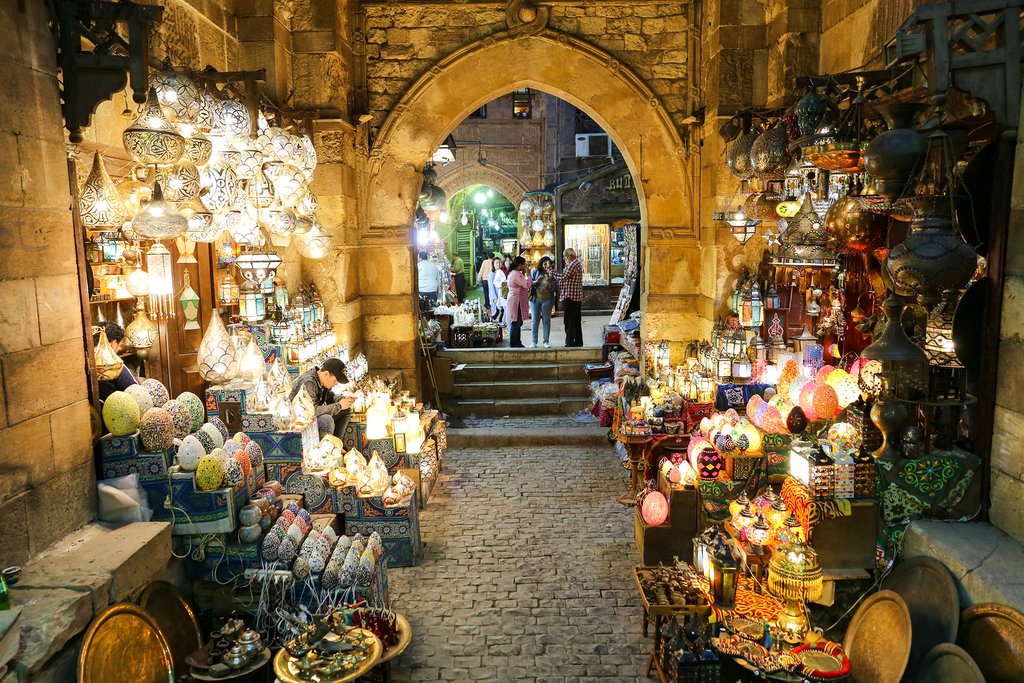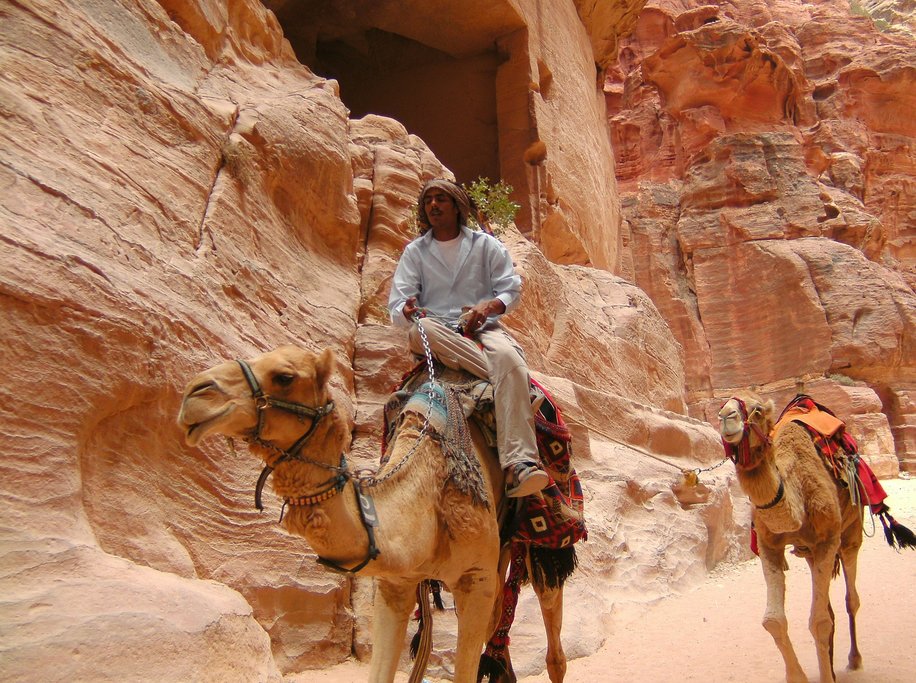Highlights
- Explore the Great Pyramids of Giza
- Visit the ancient city of Petra
- Wander through Karnak Temple
- Walk through the Valley of the Kings
- Learn about the temples at Edfu and Kom Ombo
Brief Itinerary
| Day | Highlights | Overnight |
|---|---|---|
| Day 1 | Arrive in Cairo | Cairo |
| Day 2 | Visit the Egyptian Museum and Pyramids Of Giza | Cairo |
| Day 3 | Cruise in Luxor | Luxor |
| Day 4 | Tour the Valley of the Kings | Esna |
| Day 5 | Edfu and Kom Ombo Temples | Kom Ombo |
| Day 6 | Sail to Aswan | Aswan |
| Day 7 | Aswan to Cairo | Cairo |
| Day 8 | Cairo to Amman | Amman |
| Day 9 | Tour Amman & Jerash | Amman |
| Day 10 | Amman to Petra | Petra |
| Day 11 | Petra to Wadi Rum | Wadi Rum |
| Day 12 | Wadi Rum to the Dead Sea | The Dead Sea |
| Day 13 | The Dead Sea to Amman - Catch Your Flight Home |
Detailed Itinerary
Day 1: Arrive in Cairo

Welcome to Egypt! After arriving in Cairo — one of the largest cities in Africa and in the Middle East — you'll head to your hotel. You'll be free to relax and rest in time before the tour begins. You could also start exploring the city, venturing out to try some local cuisine in one of many excellent restaurants.
Day 2: Visit the Egyptian Museum and Pyramids Of Giza

Begin the day touring the Egyptian Museum. The finest museum of Egyptian antiques in the world, it contains pharaohs' treasures dating back more than 5,000 years. The building is rectangular with a large rotunda on the ground floor containing massive exhibits, including colossal statues of Ramses II — get the best views by looking down from the upper galleries. The gold and alabaster trappings from the tomb of Tutankhamun (Tut) always draw crowds, too. Many of the Tutankhamun tomb treasures have been on display in museums around the world — including the golden mask — yet this one exhibit has always remained in Cairo.
Next, make your way to the famous pyramids in Giza. Start by visiting the pyramid of Cheops, which is the only survivor of the Seven Wonders of the Ancient World. It was built as a tomb, with the shape intended to help the spirit of the dead pharaoh rise to heaven. Next, visit the pyramid of Chephren. The best-preserved of the three main Giza pyramids, the top portion still retains the original face of smoothly finished stone, offering an idea of how the pyramids would originally have appeared. Beside Chephren is the great Sphinx, which is carved out of natural rock. Then stop by Mykerinos, the smallest of the three pyramids. Following the tour in Giza, enjoy a meal at a local Egyptian restaurant nearby. Then head back to the city to enjoy the evening in Cairo at your leisure.
Day 3: Cruise in Luxor

After breakfast, board a short one-hour flight to Luxor. This small city in the Nile Valley is located 420 miles (676 km) south of Cairo. By cruise ship, you will visit Karnak Temple, one of Egypt’s largest surviving temples. Founded in the Middle Kingdom, it was once a key religious center. You'll also visit Luxor Temple, a massive temple complex located on the east bank of the Nile. It was founded during the New Kingdom around 1400 BCE. Enjoy an evening in Luxor by dining in a local restaurant and relaxing at the hotel.
Day 4: Tour the Valley of the Kings

This morning you'll board a boat for the cruise down the Nile River. You'll stop to visit the Valley of the Kings and see rock-cut tombs for kings and powerful nobles (including Tutankhamun) from the 16th to 11th century BCE. Then continue to the Colossi of Memnon to see the ruins of Amenhotep’s memorial temple. What remains are two imposing statues of Pharaoh Amenhotep III that were erected to guard the temple's entrance.
Head next to Hatshepsut Temple. The memorial of Queen Hatshepsut is the focal point of Deir el-Bahri, a complex of mortuary temples and tombs. After the tour, make your way back to your cruise ship where you can relax on board as you sail to Esna, where you'll stay overnight.
Day 5: Edfu and Kom Ombo Temples

The next stop on your Nile cruise will be to see the temples at Edfu and Kom Ombo. Your guide will explain the significance of these temples in further detail on a horse drawn carriage tour. The Temple of Horus at Edfu was constructed between 237 BCE and 57 BCE. It is one of the best-preserved shrines in Egypt, and inside you can still make out many of its inscriptions.
The Temple of Sobek and Haroeris at Kom Ombo was dedicated to the crocodile god (Sobek) and falcon god (Haroeris). Many of the walls of its courts, halls, sanctuaries, and rooms are still intact, along with wall carvings and statues.
Chat with a local specialist who can help organize your trip.
Day 6: Sail to Aswan

Your adventure continues as you set sail for Aswan. In Aswan, you will have a chance to get off the ship and explore more sights along with your guide, including:
- Aswan High Dam: Built in the 1960s, completed in 1970, and formally inaugurated in 1971, Aswan High Dam was an engineering marvel at the time and changed the landscape of Egypt by increasing cultivable land by 30 percent and doubling its electricity supply.
- Philae Temple: There were once temples at Philae (construction began in 690 BCE), dedicated to the goddess Isis. The complex was moved from its original location on Philae Island, to its new location on Agilkia Island, due to the construction of Aswan High Dam. You'll board a small boat to learn more about the temple here.
- The Botanical Garden: You'll have time to explore the grounds of Kitchener’s Island—also known as the Botanical Garden—a 16-acre island in the Aswan archipelago located between Elephantine Island and The Nile's west bank.
Day 7: Aswan to Cairo

From Aswan, your tour coordinator will transfer you to the airport in time for your flight back to Cairo.
After checking into your hotel, you can spend the rest of the afternoon or evening exploring Cairo, indulging in local cuisine or taking in some last-minute sightseeing—before departing tomorrow.
Day 8: Cairo to Amman

Welcome to Jordan! After arriving at the Queen Alia International Airport, your driver will meet you and transport you to the capital of Amman, which will serve as your home base for the next few days of adventure.
Relax at your hotel, wander out for an incredible meal, or if your flight arrives early in the day, enjoy an optional tour of the city's highlights, complete with a delicious lunch.
Day 9: Tour Amman & Jerash

Start your morning with a city tour through Amman. Visit the Citadel, which provides beautiful views over the city. This historical site is considered one of the oldest continuously inhabited places in the entire world and is one of Amman's most important landmarks. Afterward, you'll continue to the 2nd-century Roman Theatre, located in the heart of the city.
From here, you'll drive on to Jerash to visit the world’s best-preserved Roman provincial city. Some of the ruins in the city include Hadrian's Arch, the Temple of Artemis, and the Forum. You can visit the Archeological Museum to learn more about the city's rich history.
After your visit, you'll head back to Amman for the night.
Day 10: Amman to Petra

After enjoying breakfast at your hotel, you'll journey south to Mount Nebo. According to the Old Testament, this is the lofty peak where Moses took in the view of the Promised Land and is now considered one of the holiest places in Biblical tradition. Look out at the Dead Sea and beyond, before eventually making your way to the Memorial Church of Moses, a modern structure that now houses excavated relics from the region.
Continue your day in Madaba, a charming town known for its Byzantine mosaics, including the famous Madaba Map: the oldest preserved mosaic map of the Holy Lands. You'll also make a stop in Karak, a city that was once the capital of Moab, its skyline still dominated by a castle at its center. Visiting the fortress-like structure provides an opportunity to experience firsthand the vaulted halls and passageways typical of the era, an impressive insight into the architectural and military prowess of the Crusaders.
With an evening arrival in Petra, you are able to join a nighttime tour of the ancient city—a fantastic opportunity to gain a unique perspective of the ruins before your daytime explorations the next morning.
Day 11: Petra to Wadi Rum

Today you have a full day to visit Petra, a famous UNESCO World Heritage Site.
You'll walk through the narrow Siq and admire the carvings and temples around you. Then, visit the Treasury at the end of the canyon, before you see the rest of the enormous city open up before you. Climb up to the High Place of Sacrifice, visit the Royal Tombs, explore the Roman Theater, and walk down the Colonnaded Street. You'll also have the option to take a guided tour of Petra (two to three hours).
In the late afternoon, your driver will pick you up again and take you south to the desert of Wadi Rum, where you will spend the night in a Bedouin camp and enjoy a traditional dinner.
Day 12: Wadi Rum to the Dead Sea

After breakfast, your driver will take you north to the lowest point on earth: the Dead Sea. Float effortlessly in the salty water and make a face mask (or body mask) with the mineral-rich mud that abounds the shore. You can also opt for a professional mud treatment or just spend the day relaxing in the water or in your hotel pool.
Unwind after soaking up some rays with dinner before spending the night here at the sea.
Day 13: The Dead Sea to Amman - Catch Your Flight Home

On your last morning in Jordan, you'll head back to Amman. Depending on your scheduled departure, you may have time to spend a bit more time exploring the city. Make a stop at the impressive King Abdullah Mosque, check out the contemporary art galleries lining the streets of Jebal Al-Waibdeh, or visit a bakery to grab some baklava for the plane. At the end of your stay, your driver will take you back to QAIA to check in for your flight.
